Results 21 to 30 of 39
Threaded View
-
07-04-2020, 09:56 PM #1
 First Practice Wood Turning Project with a Few Observations and Questions
First Practice Wood Turning Project with a Few Observations and Questions
First of all, I should have known better than to say I wasn't going to get into turning. Everything I've ever said I wasn't going to do, I ended up doing somehow! But once my woodworker friend put the hook in me with a bunch of shaving brush handles he turned for me, I just couldn't let it go.
Anyway, I finally got the shop organized, a sunny spot near the AC picked out for my wife's comfort, and the machine set-up with some helpful advice and a bunch of videos. Our own Cudarunner Roy has been a constant source of help and advice as he is to everyone (and more stuff to order-I swear the guy has cost me thousands!). I kinda feel like that kid everyone hates who can't even make a G chord and his Mom buys him a $3000 Taylor guitar, but I know most on here agree with the old adage "Buy quality, and buy it once." That said, this machine is rock solid and very easy to use for a rank newbie: the banjo and tool-rest move freely and lock down solid, the variable speed control is very easy and responsive to use, the centers line up perfectly, and it runs vibration-free and almost dead silent.
So after hours of newbie turning videos, it was time to see what I could accomplish. One tool demo video I watched had the guy making a shop mallet, which seemed like an easier way to start than a shaving brush! As my son works for our friend and neighbor the tree man a couple of doors down, I decided to bust my turning cherry on some plum they had recently brought home for smoking chips, so it was pretty green and soft, though quite chippy with different grain directions. I never made this much sawdust on all the wood scales I've made put together lol!
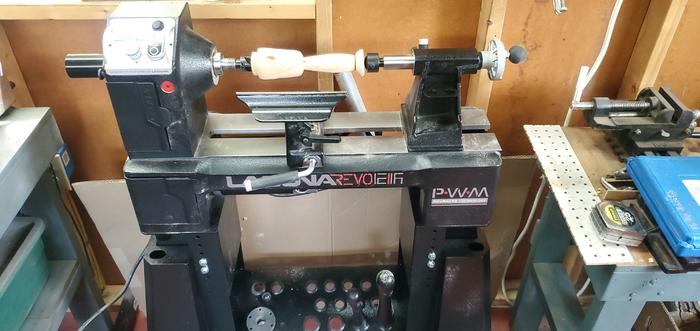
Of the 5 HSS tools they talked us into, I used 3 the most: the 3/4" roughing gouge, the 3/4" skew (especially this one!), and the 3/8" slip gouge the most. That slip gouge also seemed very tricky to get a feel for.
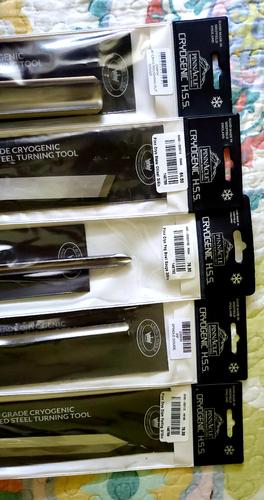
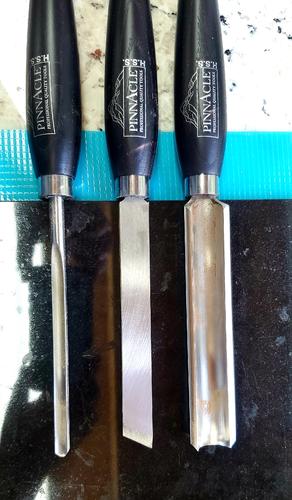
Anyway, after more scary catches than I'm ready to admit (especially on that damn 3/4" roughing gouge and the slip gouge-yikes! ), this is what I ended up with:
), this is what I ended up with:
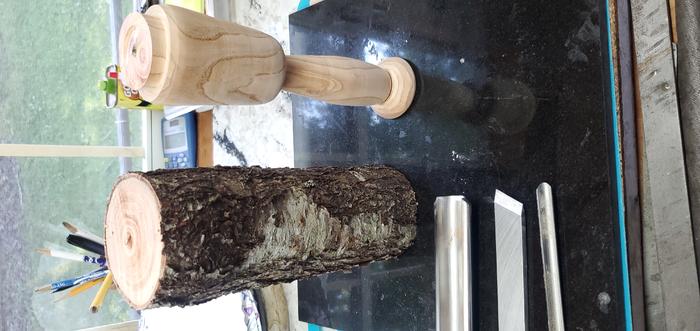
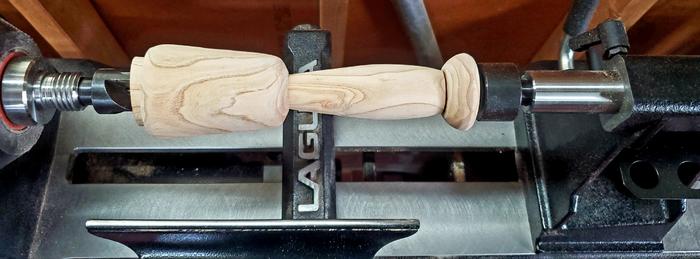
I know it's far from perfect, and the mallet part is not proportional, but I'll take it for my 1st practice piece. Once I got down to round, I only had so much diameter to work with. I'm going to center it back in the lathe for sanding and a friction polish with some beeswax/linseed oil mix I have-should I wait until it's drier for this? If so, how long?
A few Observations:
-We're going back to Woodcraft Monday for the Laguna light attachment and some other stuff we suddenly can't do without.
-Though word on the street is that a lot of people don't like skews, I found my 3/4" one extremely intuitive, and probably did 90% of the work with it. Apparently some do the majority of their work with a skew?
-I've got a 300/600 diamond card on the way for sharpening, and already have some small slip stones, micro soft ark sticks, etc. for sharpening. I'm wondering if I can refine on a 2x72 1k grit diamond belt?
A Few Questions:
-Should I get my 3/4" skew radiused? I already know I will love this approach just from watching videos.
-Any advice on rough tool speeds for the different tools?
-Any other must-have tools? (Not that we need to spend any more money lol!)
-Anybody ever try carbide tools? Seems like they're frowned upon, but much easier for beginners to use?
As I told Roy, I am a total sponge for any and all info. As there seems to be a renewed interest lately in turning, if this thread were to become sort of a "Beginner's Tips for Turning" for all who find themselves falling down this hole, I would love that.
Anyway, Happy Independence Day all-I'm about to go celebrate with a couple of IPA's and some pulled pork I smoked recently! My son and his buddies have already pissed off the neighbors and scared the dogs with some 5-inch mortar shells, so it could be an interesting night.Last edited by ScoutHikerDad; 07-04-2020 at 11:55 PM.
There are many roads to sharp.
-


 136Likes
136Likes LinkBack URL
LinkBack URL About LinkBacks
About LinkBacks









 Reply With Quote
Reply With Quote